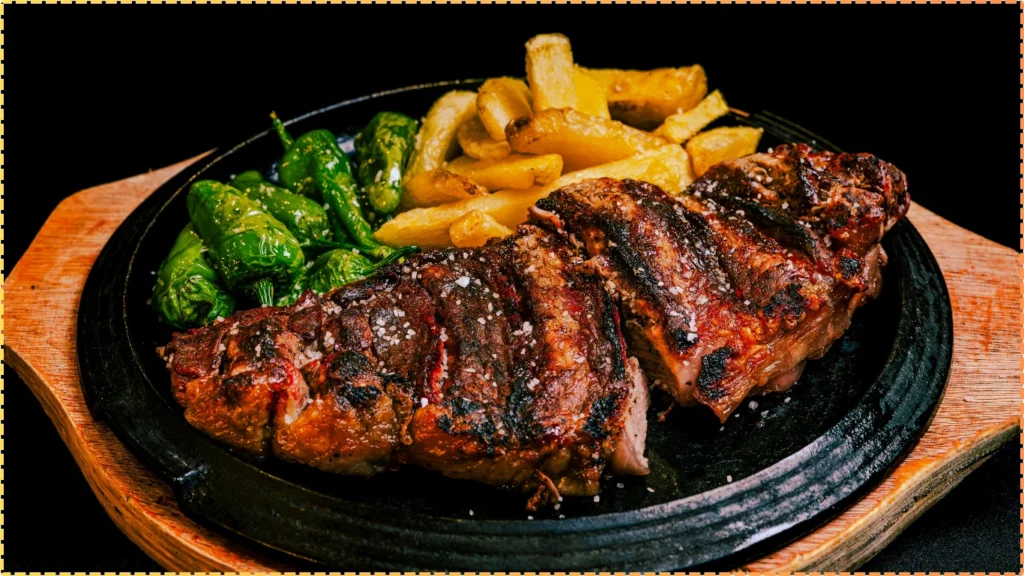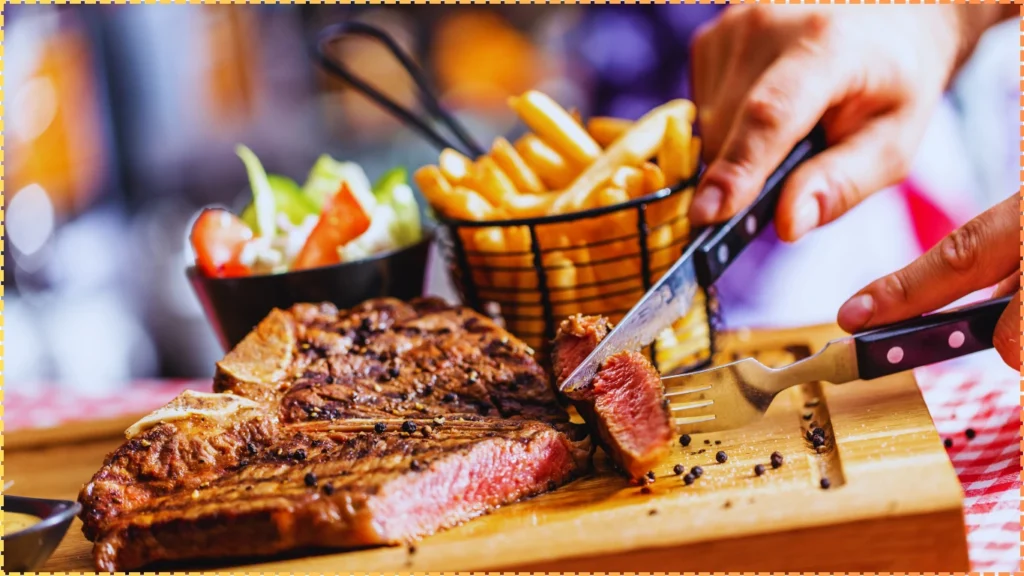Flavorful Steak Frites Sauce

Table of Contents
Ever thought the star of your steak frites could be the sauce? The right sauce can make a simple dish into a Parisian bistro favorite. But how do you pick or make the perfect one?
Remember your last steak dinner? Did the sauce enhance the beef and fries, or was it just extra? This guide shows how sauces like Béarnaise and peppercorn can elevate your meal. These ingredients are readily available at any grocery store.. Learn why homemade sauces are key and how they can make any dinner special.

Key Takeaways
- The right sauce defines the authenticity of your homemade steak frites experience.
- Classic options like Béarnaise and modern twists like herb butter are both achievable at home.
- Quality ingredients and technique matter more than exotic tools.
- Sauces balance textures and flavors to complement both beef and fries.
- Mistakes are fixable—learn pro tips to avoid common pitfalls.
Understanding the Magic Behind Steak Frites Sauce
Every great steak frites sauce recipe starts with understanding its purpose. Sauce isn’t just a side note it’s the key to elevating your classic steak frites from ordinary to extraordinary. Let’s break down what makes this element so transformative.
What Makes a Great Steak Frites Sauce
Three pillars define excellence:
- Balance: Salt, acid, and fat must work together without any single flavor dominating.
- Depth: Layers like roasted shallots or reductions add complexity to the base.
- Texture: Creamy sauces contrast with crispy frites, while thinner sauces enhance tenderness.
The Role of Sauce in Classic Steak Frites
Consider this table to see how sauces act as culinary glue:
| Sauce Type | Role | Pairing Notes |
|---|---|---|
| Béarnaise | Unites salty steak with tangy herbs | Matches well with tenderloin’s mild flavor |
| Peppercorn | Adds boldness to richer cuts | Perfect with ribeye’s marbling |
| Red Wine Reduction | Deepens savory notes | Enhances flank steak’s robustness |
How Sauce Transforms Your Steak Experience
A sauce should whisper, not shout—guiding each bite toward harmony.
Imagine a simple sirloin: a sharp horseradish cream elevates it to gourmet status. Sauce choices can:
- Balance richness (e.g., lemon in butter sauces cuts through fatty meats)
- Create contrast (cool vs. warm, thick vs. light)
- Highlight protein textures (thick sauces cling to steak; light ones drizzle over frites)
The Rich History of French Steak Frites

In the early 1900s, french steak frites became a favorite in Parisian bistros. It started as a simple meal for the working class. But its bold flavors made it a classic.
Over time, it grew into the classic steak frites loved around the world.
Regional traditions played a big role in its development. For instance:
| Region | Cut of Beef | Signature Sauce |
|---|---|---|
| Paris | Sirloin | Béarnaise |
| Provence | Herb-Rubbed Steak | Herb Butter |
| Southwest France | Garlic-Marinated Beef | Garlic Butter |
Today, this dish is a mix of tradition and new ideas. It shows the importance of honoring its past while trying new things. The classic steak frites remains a symbol of French culinary excellence.
Essential Ingredients for an Authentic Steak Frites Sauce
Choosing the right ingredients is key to a great steak frites sauce. Each part adds to the sauce’s texture and taste. Let’s explore what you need to make it perfect.
Must-Have Base Components
Start with these essentials:
- Shallots: Provide mild onion flavor without sharpness
- Unsalted butter: Adds richness and emulsification
- White wine: Choose dry varieties like Chardonnay or Champagne
- Vegetable or beef stock: Builds foundational broth flavor
Flavor-Enhancing Additions
These take your sauce to the next level:
- Fresh herbs (tarragon, chervil, parsley)
- Black peppercorns (freshly cracked for aroma)
- Mustard (Dijon adds tang)
- Espresso for depth (optional but impactful)
A classic ratio: 1 part herbs to 3 parts base ingredients works well.
Ingredient Substitutions When You’re in a Pinch
When key items are unavailable, use these swaps:
| Original | Substitute |
|---|---|
| Shallots | Yellow onion (minced finely) |
| White wine | Chicken broth + lemon juice |
| Fresh tarragon | 1 tsp dried tarragon + 1 tsp fresh parsley |
Quality Considerations for the Best Results
Always choose fresh ingredients for the best sauce:
- Use European-style butter (82%+ butterfat)
- Opt for fresh lemon juice over bottled
- Buy whole peppercorns, not pre-ground
Pro tip: Never use ultra-processed ingredients like powdered mustard. Fresh components make all the difference in sauce steak frites authenticity.
View :savory-shaved-beef-
Classic Béarnaise: The Traditional Steak Frites Companion
Béarnaise sauce is the star of steak frites, a French gem that makes your meal special. It’s made with butter, egg yolks, and tarragon. This mix balances richness with fresh herb flavors. Learning to make it is key to enjoying a classic dining experience.
Key ingredients to remember:
- Fresh tarragon: essential for its licorice-like aroma
- Clarified butter: ensures smooth texture
- White wine vinegar: sharpness cuts through fatty cuts
Follow these steps for success:
- Whisk egg yolks and reduction over gentle heat until thickened
- Slowly blend in clarified butter to form an emulsion
- Season with lemon juice to balance acidity
| Issue | Fix |
|---|---|
| Sauce separates | Remove from heat before adding butter |
| Overcooked yolks | Use a double boiler to prevent scrambling |
“The sauce steak frite must be served warm but not hot to preserve its silkiness,” says Chef Antoine Duval of Parisian bistro Le Coq Hardy.
Serve your delicious steak frites with Béarnaise at room temperature. Pair it with a medium-rare steak and crispy frites for the best taste. Adjust the seasoning just before serving to keep it fresh. With practice, this sauce will be your favorite for steak nights.
Peppercorn Sauce: Adding Bold Flavor to Your Steak Frites
Peppercorn sauce adds a bold twist to your steak and frites. It offers a spicy contrast to tender beef and crispy fries. If you want a gourmet steak frites experience, mastering this sauce is key. Unlike Béarnaise, peppercorn sauce blends peppery notes with rich flavors for a modern twist.
Selecting the Right Peppercorns
Choosing the right peppercorns is crucial for your sauce. Here’s how each type contributes:
- Black peppercorns: Sharp, earthy heat.
- Green peppercorns: Bright, fresh flavor from unripe berries.
- White peppercorns: Mild, floral undertones (ideal for lighter sauces).
- Pink peppercorns: Sweet, fruity notes for a sophisticated touch.
Balancing Heat and Creaminess
Perfect peppercorn sauce balances boldness and richness. Follow these tips:
- Start with a light roux to stabilize the base.
- Add cream gradually to control thickness and mellow heat.
- Use a whisk to blend peppercorns smoothly into the sauce.
Step-by-Step Preparation Guide
- Toast peppercorns: Sauté whole peppercorns in butter until fragrant. Cool and crush coarsely.
- Create a velouté: Whisk warm broth with a butter-flour roux until smooth.
- Incorporate flavor: Blend crushed peppercorns into the sauce, adding a splash of brandy for depth.
- Adjust consistency: Simmer to thicken slightly, ensuring it clings to steak and frites.
Adjust the seasoning gradually to match your preferred level of heat.
Red Wine Reduction: A Sophisticated Steak Frites Sauce Recipe
Making a red wine reduction elevates your steak frites. Choose a rich red wine like Cabernet Sauvignon or Pinot Noir. Steer clear of cheap wines for the best flavor.
Simmer the wine until it’s halved to intensify the taste. Add shallots and garlic for a fragrant aroma. Mix in butter for a creamy texture. Season with thyme and a bit of sugar to balance the acidity.
- Pour 1 cup of wine into a saucepan and boil until reduced by 50%.
- Stir in minced shallots and a bay leaf. Cook until soft.
- Whisk in 2 tbsp Dijon mustard and ½ cup beef stock.
- Remove from heat. Gradually add ¼ cup cold butter to emulsify.
| Wine Type | Flavor Profile | Pairing Notes |
|---|---|---|
| Cabernet Sauvignon | Full-bodied with dark fruit notes | Complements thick cuts like ribeye |
| Pinot Noir | Lighter, berry-forward | Works well with filet mignon |
| Merlot | Smooth tannins, plum undertones | Matches rosemary-seasoned steaks |
Pro tip: Taste before adding salt wine already contains natural acidity.
Get creative by adding minced mushrooms or a splash of balsamic vinegar. This method is used by top steak frites places, making a sauce that sticks to your steak. Serve it right away for the best taste. Or, store it in an airtight container for up to 3 days. Learn this sauce, and your homemade steak frites will be as good as any fancy restaurant’s.
Herb Butter Sauces: Simple Yet Decadent Options
Turn your homemade steak frites into gourmet with herb butters. These sauces melt into your meal, adding flavor without hard work.
Garlic and Herb Compound Butter
Start by softening unsalted butter to room temperature. Mix in minced garlic, fresh herbs like parsley, thyme, or rosemary, and a pinch of salt. Roll the mixture into a log, chill, and slice before serving. This recipe works wonders for steak frites, adding freshness with minimal effort.
Blue Cheese Butter Variation
Balance bold flavors by combining softened butter with crumbled Maytag or Roquefort blue cheese. Add a drizzle of honey and a splash of cream to mellow sharpness. Roll into a log and freeze for later use—ideal for gourmet steak frites with depth.
Making Ahead and Storage Tips
- Shape butter mixtures into logs, wrap tightly in parchment, and freeze for up to 3 months.
- Thaw frozen logs overnight in the fridge or microwave briefly before serving.
- Store uncooked logs in an airtight container for 1 week in the fridge.
Prep these butters ahead of time to streamline your homemade steak frites dinners. Their convenience won’t sacrifice flavor, making them a pro’s secret for effortless elegance.
Perfecting Your Homemade Steak Frites With the Right Sauce Technique
Getting the timing and texture right in your steak frites sauce recipe makes every bite special. Even the finest ingredients won’t impress without the right technique. These tips will help you turn a good meal into an unforgettable one.
Timing Your Sauce with Your Steak
Keep everything hot and fresh by coordinating your cooking steps. Prepare sauce parts like shallots or herbs early. But, make emulsions like béarnaise when the steak rests. Here’s a simple plan:
- Chop veggies and measure spices while heating your skillet
- Simmer reductions while cooking steak to medium-rare
- Whip final sauces in the last 5-7 minutes of fries baking
Achieving the Perfect Consistency
Pro chefs use the nappe test: drizzle sauce over the back of a spoon. It should coat smoothly without dripping. If it’s too thin, stir in a cornstarch slurry to thicken. Too thick? Thin with a splash of wine or butter. Always taste before serving.
Troubleshooting Sauce Problems
Common issues and fixes:
- Separated emulsion: Whisk vigorously over low heat while adding butter drops
- Grainy texture: Strain through a mesh sieve immediately
- Over-reduced sauce: Add a tablespoon of warm stock to loosen
These tips will help you fix sauce problems like a pro. This way, your homemade steak frites will always impress without any kitchen stress.
Pairing Your Sauce with the Perfect Cut of Beef and Frites
Choosing the right steak and frites is key to a balanced dish. Match sauce richness to beef tenderness. For example, a velvety béarnaise sauce goes well with marbled ribeye. Meanwhile, peppercorn sauce brings out the best in lean sirloin.
When it comes to frites, crispness is crucial. Thick-cut fries are better at holding sauce, just like in a steak frites restaurant. This ensures your dish has the perfect texture.
| Sauce Type | Best Beef Cut | Frites Style |
|---|---|---|
| Béarnaise | USDA Prime ribeye | Double-fried Russet potatoes |
| Peppercorn | Grass-fed sirloin | Crispy wedge-cut fries |
| Red wine reduction | Filet mignon | Hand-cut Yukon Gold frites |
Cook steak to your liking, then place sauce right on top. Serve frites on the side to keep them crispy. Remember, a light sprinkle of sea salt and cracked pepper on fries adds flavor.
For a restaurant touch, drizzle sauce around the plate, not over the fries. This keeps the textures of meat, sauce, and fries distinct.
Try different cuts like hanger steak for bold sauces or tenderloin for delicate flavors. Always pair sauce intensity with beef fat content. For a classic choice, pair tenderloin with red wine reduction for a dish that’s both indulgent and thoughtful.
Restaurant Secrets for Gourmet Steak Frites at Home
Turn your kitchen into a steak frites restaurant with these tips. Learn techniques, tools, and presentation tricks from the best steak frites in town. Make your meals special.
Professional Techniques You Can Master
- Deglaze like a chef: Use wine or broth to scrape pan fond for maximum flavor.
- Emulsify butter properly: Add cold butter cubes slowly to sauces for a silky texture.
- Strain sauces thoroughly: Use a fine-mesh sieve to remove lumps and achieve restaurant-smooth results.
Equipment That Makes a Difference
- Heavy-duty saucepan: Retains heat for even sauce reduction.
- Chinois strainer: Ensures flawless sauce consistency.
- Squeeze bottles: Precision sauce drizzling for presentation.
- Cast-iron skillet: Perfect for searing steak to restaurant-quality crispness.
Presentation Tips for Impressive Results
Restaurant chefs know that presentation sells. Try these tricks:
- Plate layout: Place steak off-center, surrounded by frites for balance.
- Sauce application: Drizzle sauce in a zigzag pattern to highlight each component.
- Garnish strategically: Add microgreens or a lemon wedge for freshness and color.
“Excellence lies in the finer details that set good apart from great. A well-plated dish tells a story.” — Executive Chef, Parisian Bistro
With these secrets, you’ll serve meals that rival the best steak frites in town. Improve every part, from sauce technique to plating. Enjoy a memorable dining experience at home.
Conclusion: Creating Your Signature Steak Frites Experience
You’ve learned about making steak frites sauce, from béarnaise to peppercorn. Now, mix these tips to make a dish that shows off your taste. Think about the basics like butter, herbs, and acidity in a steak frites recipe. Try new flavors, like garlic or herbs, to make it your own.
Getting the sauce right is crucial. Whether you stick to french steak frites or try new things, practice helps. Keep a journal of your cooking to see how you improve.Minor adjustments can lead to significant improvements over time.
Sharing your dish with others makes it special. Serve it with crispy frites and a juicy steak, then ask for feedback. Every tweak brings you closer to your signature sauce. It’s perfect for any meal, adding a personal touch to a classic.
Cooking is all about creativity, starting with tradition. Use what you’ve learned to create something new. Next time you make steak and frites, let your sauce tell your story, one bite at a time.
FAQ
What is the best sauce for steak frites?
The best sauce for steak frites depends on what you like. Classic choices are Béarnaise, peppercorn sauce, and red wine reduction. Each adds a special flavor that goes well with the steak and frites.
How can I make homemade steak frites sauce?
Making steak frites sauce at home is easy. Try Béarnaise or a garlic and herb butter. Cooking resources have recipes with step-by-step guides to help you succeed.
What pairs well with steak frites?
Steak frites are great with Béarnaise or peppercorn sauce. Choose a good cut of beef like ribeye or filet mignon. High-quality frites also make a difference.
Can I use different types of steak for steak frites?
Yes, you can! Ribeye and filet mignon are common, but sirloin works too. Pick a steak that matches the sauce for a better taste.
What are some variations of steak frites sauce?
There’s more than Béarnaise. Try blue cheese butter or garlic butter with herbs. You can also make red wine reduction or chimichurri. Experiment to find your favorite.
How do I achieve the perfect consistency for my steak frites sauce?
For the right sauce consistency, reduce it slowly to intensify flavors. Use the nappe test to check if it coats the spoon. Adjust with butter or stock if needed.
What is the history of steak frites?
Steak frites has a long history in French cuisine. It started in Paris in the early 20th century. Knowing its history adds to the joy of cooking and eating it.
How should I serve steak frites for the best presentation?
For a great look, arrange steak and frites neatly. Drizzle sauce and garnish with herbs. It looks good and makes the meal better.

2 thoughts on “Flavorful Steak Frites Sauce”